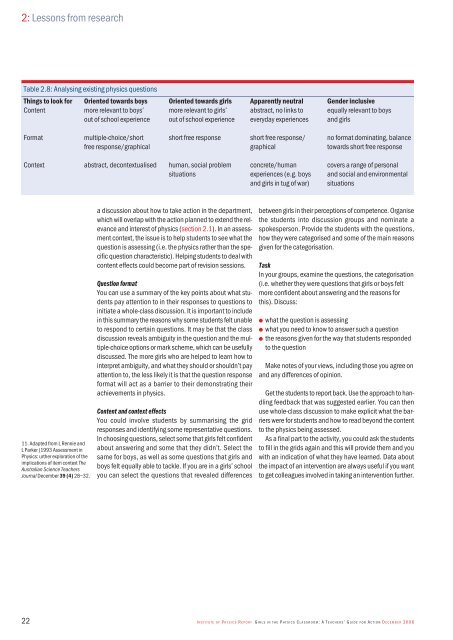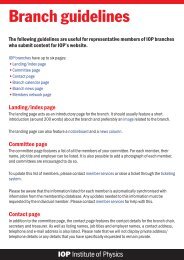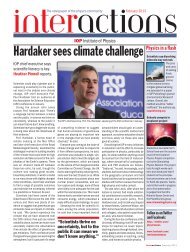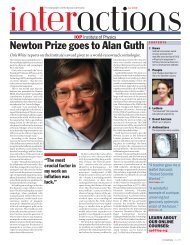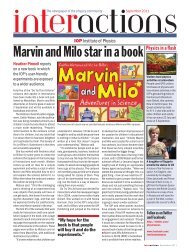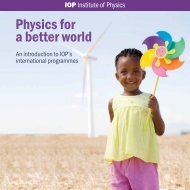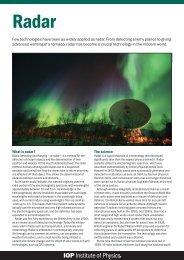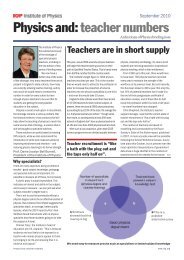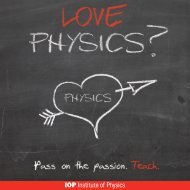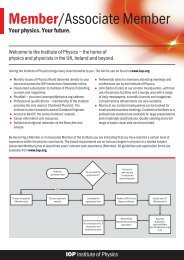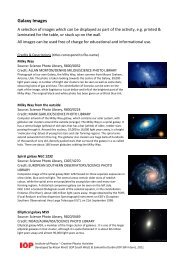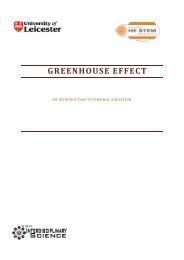Girls in the Physics Classroom: A Teachers' Guide - Institute of Physics
Girls in the Physics Classroom: A Teachers' Guide - Institute of Physics
Girls in the Physics Classroom: A Teachers' Guide - Institute of Physics
Create successful ePaper yourself
Turn your PDF publications into a flip-book with our unique Google optimized e-Paper software.
2: Lessons from research<br />
Table 2.8: Analys<strong>in</strong>g exist<strong>in</strong>g physics questions<br />
Th<strong>in</strong>gs to look for Oriented towards boys Oriented towards girls Apparently neutral Gender <strong>in</strong>clusive<br />
Content more relevant to boys’ more relevant to girls’ abstract, no l<strong>in</strong>ks to equally relevant to boys<br />
out <strong>of</strong> school experience out <strong>of</strong> school experience everyday experiences and girls<br />
Format multiple-choice/short short free response short free response/ no format dom<strong>in</strong>at<strong>in</strong>g, balance<br />
free response/graphical graphical towards short free response<br />
Context abstract, decontextualised human, social problem concrete/human covers a range <strong>of</strong> personal<br />
situations experiences (e.g. boys and social and environmental<br />
and girls <strong>in</strong> tug <strong>of</strong> war) situations<br />
11. Adapted from L Rennie and<br />
L Parker (1993 Assessment <strong>in</strong><br />
<strong>Physics</strong>: ur<strong>the</strong>r exploration <strong>of</strong> <strong>the</strong><br />
implications <strong>of</strong> item context The<br />
Australian Science Teachers<br />
Journal December 39 (4) 28–32.<br />
a discussion about how to take action <strong>in</strong> <strong>the</strong> department,<br />
which will overlap with <strong>the</strong> action planned to extend <strong>the</strong> relevance<br />
and <strong>in</strong>terest <strong>of</strong> physics (section 2.1). In an assessment<br />
context, <strong>the</strong> issue is to help students to see what <strong>the</strong><br />
question is assess<strong>in</strong>g (i.e. <strong>the</strong> physics ra<strong>the</strong>r than <strong>the</strong> specific<br />
question characteristic). Help<strong>in</strong>g students to deal with<br />
content effects could become part <strong>of</strong> revision sessions.<br />
Question format<br />
You can use a summary <strong>of</strong> <strong>the</strong> key po<strong>in</strong>ts about what students<br />
pay attention to <strong>in</strong> <strong>the</strong>ir responses to questions to<br />
<strong>in</strong>itiate a whole-class discussion. It is important to <strong>in</strong>clude<br />
<strong>in</strong> this summary <strong>the</strong> reasons why some students felt unable<br />
to respond to certa<strong>in</strong> questions. It may be that <strong>the</strong> class<br />
discussion reveals ambiguity <strong>in</strong> <strong>the</strong> question and <strong>the</strong> multiple-choice<br />
options or mark scheme, which can be usefully<br />
discussed. The more girls who are helped to learn how to<br />
<strong>in</strong>terpret ambiguity, and what <strong>the</strong>y should or shouldn’t pay<br />
attention to, <strong>the</strong> less likely it is that <strong>the</strong> question response<br />
format will act as a barrier to <strong>the</strong>ir demonstrat<strong>in</strong>g <strong>the</strong>ir<br />
achievements <strong>in</strong> physics.<br />
Content and context effects<br />
You could <strong>in</strong>volve students by summaris<strong>in</strong>g <strong>the</strong> grid<br />
responses and identify<strong>in</strong>g some representative questions.<br />
In choos<strong>in</strong>g questions, select some that girls felt confident<br />
about answer<strong>in</strong>g and some that <strong>the</strong>y didn’t. Select <strong>the</strong><br />
same for boys, as well as some questions that girls and<br />
boys felt equally able to tackle. If you are <strong>in</strong> a girls’ school<br />
you can select <strong>the</strong> questions that revealed differences<br />
between girls <strong>in</strong> <strong>the</strong>ir perceptions <strong>of</strong> competence. Organise<br />
<strong>the</strong> students <strong>in</strong>to discussion groups and nom<strong>in</strong>ate a<br />
spokesperson. Provide <strong>the</strong> students with <strong>the</strong> questions,<br />
how <strong>the</strong>y were categorised and some <strong>of</strong> <strong>the</strong> ma<strong>in</strong> reasons<br />
given for <strong>the</strong> categorisation.<br />
Task<br />
In your groups, exam<strong>in</strong>e <strong>the</strong> questions, <strong>the</strong> categorisation<br />
(i.e. whe<strong>the</strong>r <strong>the</strong>y were questions that girls or boys felt<br />
more confident about answer<strong>in</strong>g and <strong>the</strong> reasons for<br />
this). Discuss:<br />
● what <strong>the</strong> question is assess<strong>in</strong>g<br />
● what you need to know to answer such a question<br />
● <strong>the</strong> reasons given for <strong>the</strong> way that students responded<br />
to <strong>the</strong> question<br />
Make notes <strong>of</strong> your views, <strong>in</strong>clud<strong>in</strong>g those you agree on<br />
and any differences <strong>of</strong> op<strong>in</strong>ion.<br />
Get <strong>the</strong> students to report back. Use <strong>the</strong> approach to handl<strong>in</strong>g<br />
feedback that was suggested earlier. You can <strong>the</strong>n<br />
use whole-class discussion to make explicit what <strong>the</strong> barriers<br />
were for students and how to read beyond <strong>the</strong> content<br />
to <strong>the</strong> physics be<strong>in</strong>g assessed.<br />
As a f<strong>in</strong>al part to <strong>the</strong> activity, you could ask <strong>the</strong> students<br />
to fill <strong>in</strong> <strong>the</strong> grids aga<strong>in</strong> and this will provide <strong>the</strong>m and you<br />
with an <strong>in</strong>dication <strong>of</strong> what <strong>the</strong>y have learned. Data about<br />
<strong>the</strong> impact <strong>of</strong> an <strong>in</strong>tervention are always useful if you want<br />
to get colleagues <strong>in</strong>volved <strong>in</strong> tak<strong>in</strong>g an <strong>in</strong>tervention fur<strong>the</strong>r.<br />
22 I NSTITUTE OF P HYSICS R EPORT G IRLS IN THE P HYSICS C LASSROOM: A TEACHERS’ GUIDE FOR A CTION D ECEMBER 2006


